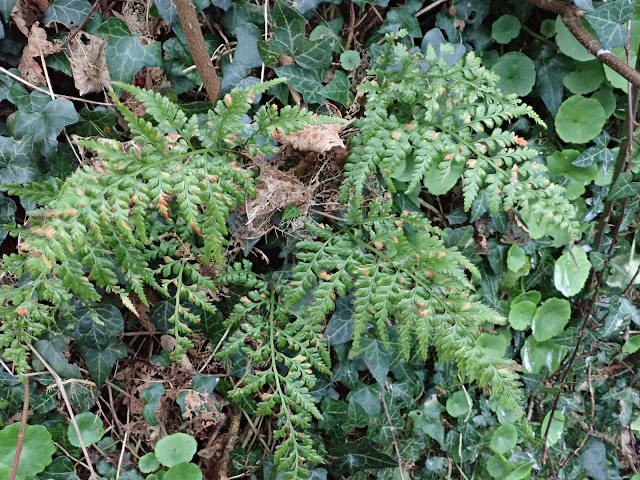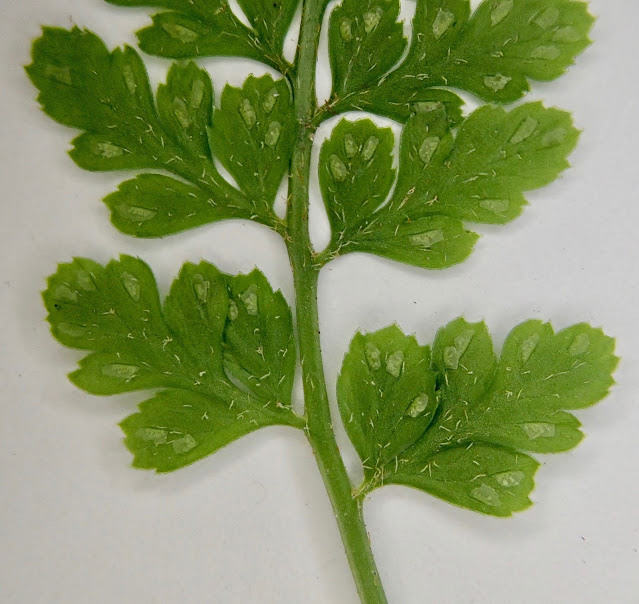Lanceolate Spleenwort in West Cork.
A search for new ferns while on a winter break in West Cork, December 2021.
Two possible targets were Irish Spleenwort (Asplenium onopteris) and Lanceolate Spleenwort (Asplenum obovatum). Both are rarely recorded, especially Irish Spleenwort which has no recent records in County Cork.
Both species hybridise with the variable Black Spleenwort (Asplenium adiantum-nigrum) so some care would be needed in identification, especially as I have no previous experience. A site near Bandon, Keye's Bridge, was checked for Irish Spleenwort, where it had been seen in the past but only Black Spleenwort was found. About ten quite large plants were seen. One possibly might have been showing some intermediate characterises of Irish Spleenwort but more likely was just variation.
The new book on ferns, 'Britain's Ferns' by James Merryweather, uses photos taken in Corfu which shows plants of Irish Spleenwort which are more similar to Black Spleenwort than those seen in Ireland. The Irish plants are more extreme in their fine dissection.
The Keye's Bridge visit did allow me to get more familiar with Black Spleenwort. These were large plants that had fronds with pinna over 20cm of rachis.
 |
| Black Spleenwort at Keye's Bridge. 19Dec2021 |
 |
| Black Spleenwort, large frond. 19Dec2021 |
 |
| Black Spleenwort. Keye's Bridge. Linear sori are long. 19Dec2021 |
 |
| Black Spleenwort. 27th Dec2021 |
 |
| Black Spleenwort 27Dec2021. Brown strip tapers out on underside of rachis. |
It looks as if nothing has changed since 2009. The ferns were still growing on about ten clumps high on the wall. The house has been done up but that's about it. I took photos.
The first thing to say is that these clumps of ferns looked similar to Black Spleenwort but were somewhat different. Late December is probably not the best time of year and they were a bit bashed up but the fronds which stayed close to the wall were still in good condition and even at a distance looked different. Something about the way the terminal pinnae stick out with a clear gap between them and form a ladder each side of the rachis was unlike the Black Spleenwort I had seen earlier that day. Out on the end of the Beara, all these plants are small and the fronds are typically not more than 7cm long compared with the 20cm of the more inland Black Spleenwort (Keye's Bridge, Bandon).
 |
| Lanceolate Spleenwort, 31Dec2021, |
 |
| Lanceolate Spleenwort. Detail of frond showing ladder of pinna on each side of the rachis. |
Another characteristic which the above photo shows, is that the pinnules on the lower pinna are cut back to the pinna stem making this a bipinnate frond. This is not a useful distinction as the small Black Spleenwort are also often bipinnate ( pinnate to bipinnate to tripinnate). What is slightly more interesting is that the pinnules are rounded (obovate) and have points, like little hands with tiny short fingers.
Shape:
The most important difference as stated on page 36 of 'Britain's Ferns' is
Lanceolate Spleenwort Black Spleenwort
Fronds- Ovate-lanceolate in outline narrowing Triangular in outline. broadest
at the base. Basal pinna weakly inflexed. at the base.
Pinna - lanceolate shape triangular shape
Pinnules- obovate shape lanceolate shape
(Note Obovate , egg-shaped with the broadest part near the apex.)
My photos did not support the pinna shapes as stated above. Maybe this is due to small plant size.
I could see that the Lanceolate Spleenwort has fronds that are not triangular. The pinnae were often triangular in the sense that the pinnules get larger towards the base on the pinna, not lanceolate. These pinnules were rounded/obovate.
The main point is that the frond is not triangular with the lowest pinnae being slightly smaller than the next pair up. I would consider the pinnae to be triangular rather than lanceolate. Maybe larger plants show a lanceolate shape as stated in 'Britain's Ferns'. The lower pinnae are clearly supporting separate (stalked) pinnules (example highlighted in blue), which are quite rounded in shape. The terminal pinnae are stalked.
The pinnae start off being opposite and become more and more alternate as you go up the rachis. Some fronds had opposite pinnae all the way up but others were alternate for most of the way up. Lots of variation on this feature and it is probably not that useful. I have yet to see a Black Spleenwort with opposite pinnae going all the way up the rachis.
 |
| Lanceolate Spleenwort. Kilcatherine, Beara. |
Another frond which again is lanceolate in outline - certainly not triangular. Pinnae shape not as open on this frond but pinnules are still rounded. Ultimate segments near the apex are stalked.
 |
| Lanceolate Spleenwort, Kilcatherine, Beara. |
Although the tip of the frond is rather damaged this frond displays the ladder effect of the pinnae sticking out at right angles in a line. Black Spleenwort tends to have more upswept pinnae but this is a marginal feature.
 |
| Lanceolate Spleenwort. Detail of pinnule showing the serrated outer margin with sharp tips. |
 |
| Black Spleenwort. Detail showing similar sharp tips which is not always present on some plants. |
 |
| Black Spleenwort , typical small frond from West Beara. |
 |
| Lanceolate Spleenwort. |
The above photo shows the short indusia which are at most, three times as long as wide in Lanceolate Spleenwort. They also start towards the margin rather than at the base. The tiny hair like scales that are present on the rachis and underside of the pinnules, a feature that Black Spleenwort can also have.
 |
| Lanceolate Spleenwort. A more mature frond showing indusia and sori. |
The shape and position of the of the indusia are useful in separation of Lanceolate and Black Spleenwort. The above photo shows very short indusia at most three times as long as wide, plus the starting point is further out from the base in comparison to Black Spleenwort.
I made a second trip back to Kilcatherine to double check I really had found Lanceolate Spleenwort and to exclude the possibility that some were hybrids. Black Spleenwort is quite a common plant in the area. More photos were taken and in the end I was happy.
Something in the shape of the fronds is different even before you look at the outline shape, but is hard to put into words that do not fall foul of the variation between fronds. Size of fronds makes a big difference and all the Black Spleenwort I found this far west, are small. Getting very familiar with Black Spleenwort would seem important before looking for the rare species and I am only starting on this journey.
The good news was that on the 4th Jan on a walk out the road on Dursey Island, I was looking at the Black Spleenwort in the roadside bank when I spotted something different, a Lanceolate Spleenwort growing in a crack between stones in the bank. A new record for Dursey Island.
 |
| Lanceolate Spleenwort, 4th Jan 2022. Dursey Island. |
Lanceolate Spleenwort is called Aspenium billotii in C.N. Page, The Ferns of Britain and Ireland but the scientific name has been updated to A. obovatum. Two sub-species are known, subspecies obovatum is found in SW Europe and Mediteranean but has not been recorded in the British Isles. It is a diploid whereas A. obovatum subsp. lanceolatum is a autotetraploid. ( ref Plant Crib 1998, BSBI) The Plant Crib has an interesting table to separate Black and Lanceolate Spleenwort including a comment on habit.
Black Spleenwort is a plant rarely with a well-formed rosette , with few leaves whereas Lanceolate usually forming a compact rosette of many (15+) leaves amongst old persistent leaves and petioles. I did not count the number of fronds but I think my photos did show these features. Indusia length is noted as 1-3mm in Black Spleenwort and 1-2mm in Lanceolate which does not sound much of a difference but together with the position actually quite a useful ID feature.
Resources
Page, C. N. (1982) The Ferns of Britain and Ireland. Cambridge University Press.
Merryweather, J (2020) Britain's Ferns. Princeton University Press.
Peter Leonard
Rampton, Cambridgeshire. 13th January 2022





No comments:
Post a Comment